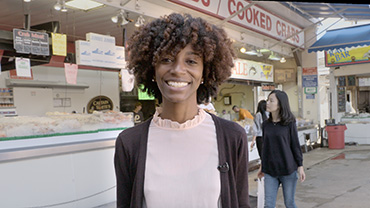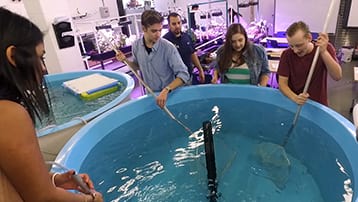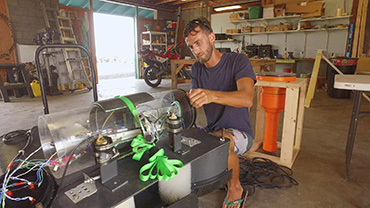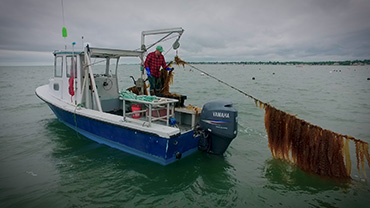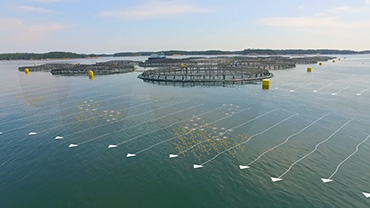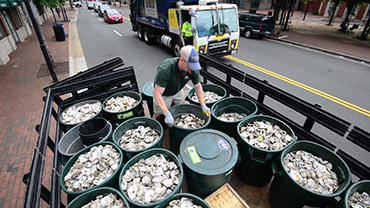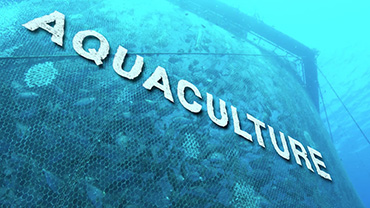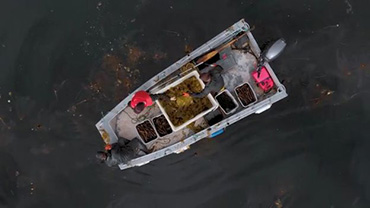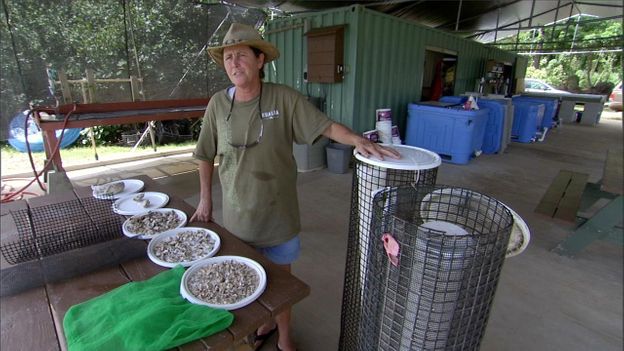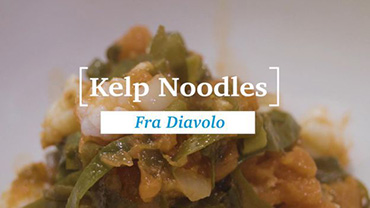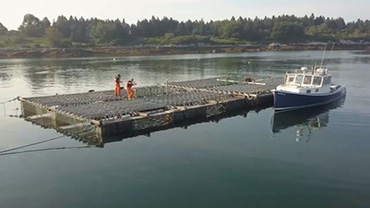Transcript
NARRATOR:
So my name is Bren Smith, I’m Executive Director of Greenwave. I was born and raised in Newfoundland Canada and I dropped out of high school when I was 14 and headed out to sea. I fished the globe. It was at the height of industrial fishing. It was clear to us that it wasn’t sustainable. So I went on this search for sustainability.
Music Up
So I'm a 3D ocean farmer, and what you should do is imagine an underwater garden.
We’ve got floating long lines. And from there we grow our mussels, our scallops and our seaweeds.
And then below that we have cages where we have our oysters and clams.
Our crops require zero inputs to grow, so that means no freshwater, no fertilizer, no feed. Growing cattle and pigs on land is incredibly resource intense. It takes water, and tons of feed, but what we're farming requires so few resources. We don't have to feed our sea vegetables. We don't have to feed our shellfish. They're just eating what's in the water, filtering what's in the water. And so using this entire vertical column we are able to grow huge amounts of food in a small area.
So all along our coastlines, we can have these little small farms dotting the coastline and producing incredible amounts of food, but it's not going to ruin our oceans.
Once you get over the embarrassment of growing vegetables, it’s beautiful stuff. I’m actually proud of this. The chefs are loving this whole leaf.
We love kelp because of how fast it grows and what season we're able to grow it in.
We found Kelp!
Kelp spores start appearing in around September, and you'll see, in the leaves you'll see these chocolate stripes, and that means the kelp is reproductive. So we go out and get two or three pieces, we take those pieces of kelp with the sporous tissue and we put it into the tanks with a piece of PVC, like a plastic pipe, and there's string wrapped around that piece of plastic pipe, and the spores, the little kelp spores attach to that string. And then by November, they're big enough for us to put them out on the farm.
The first three months, it just grows little by little, and as soon as you hit January, it starts
growing, so, so, so, so fast. And it'll be these huge fifteen foot leaves by the time we harvest.
One of our most popular dishes is Kelp noodles.
We are making a Kelp Fra Diavolo. This is what you can do at home if you’re like me and you don’t know how to cook!
Oh! (laughs)
It’s alright, I have a red shirt on.
Imagine like a six foot noodle that’s bright green and then we serve it not as seafood, but as a vegetable.
I mean, it’s delicious and it’s not what you think in terms of seafood. These ocean plants are vegetables and so when we approach them like that, that’s when the seafood plate becomes delicious.
Oh that was yummy! Oh really good.
Got a lot of noodle there huh? (Laughing)
We want to set into the wind from here, I think.
This goes to the anchor line, that goes to the Kelp line.
So the crops we grow are these agents of sustainability. Our oysters filter up to fifty gallons of water a day pulling nitrogen out of the water column. And too much nitrogen is one of the causes of the dead zones that are spreading throughout our globe. Our kelp soaks up five times more carbon than land-based plants. We're climate farmers helping restore our seas, mitigate climate change while also growing good, delicious,
beautiful food.
These are our mussel socks. The whole idea is to do polyculture and grow as many different species out on our farms.
I love being an ocean farmer. It’s such an interesting way to make a living, to have a small business and really create a future for my kids too. But it’s not easy. I’m out there all winter, in twenty degree weather breaking ice with sledge hammers. I mean, my body is soar at the end of the day and my hands are kindov like the claws of a lobster. Alright, but it is something really drives me. It’s why I wake up every morning. I want to die one day on the sea, right? I want to sink with my boat, and that will be success because I came at this thirty years ago asking the question, how do I spend my life on the ocean? How do I spend my life, with a boat, feeding people...and that’s where I get my meaning.
 An official website of the United States government.
Here's how you know we're official.
An official website of the United States government.
Here's how you know we're official.

